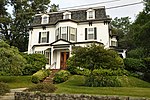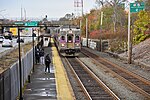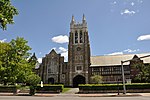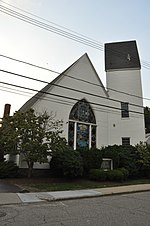Joseph L. Stone House

The Joseph L. Stone House is a historic house and carriage barn at 77 and 85 Temple Street in Newton, Massachusetts. The 2+1⁄2-story house, now at 77 Temple Street, has a brick first floor and wood frame upper floors, with a roughly three-part facade. On the left is a projecting section with a gabled roof, and on the right is a rounded two story tower section topped with an octagonal roof. In between is a recessed porch on the second floor, with a projecting gabled dormer above. The walls are sheathed in decorative shingle work, and the porch and porte-cochere are elaborately decorated. The carriage barn, now converted to a residence at 85 Temple, is of similar styling. The house and carriage barn were built in 1881 by Joseph L. Stone, a banker.The buildings were listed on the National Register of Historic Places in 1986.
Excerpt from the Wikipedia article Joseph L. Stone House (License: CC BY-SA 3.0, Authors, Images).Joseph L. Stone House
Temple Street, Newton West Newton
Geographical coordinates (GPS) Address Nearby Places Show on map
Geographical coordinates (GPS)
| Latitude | Longitude |
|---|---|
| N 42.344166666667 ° | E -71.229722222222 ° |
Address
Temple Street 95
02465 Newton, West Newton
Massachusetts, United States
Open on Google Maps









